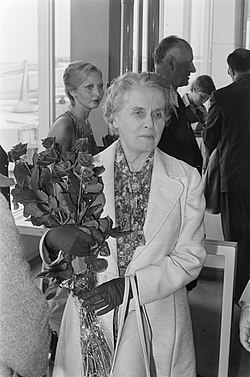Ninette de Valois
British dancer, teacher, choreographer and director of classical ballet From Wikipedia, the free encyclopedia
Remove ads
Dame Ninette de Valois OM CH DBE FRAD FISTD (6 June 1898 – 8 March 2001) was an Irish-born British dancer, teacher, choreographer and director of classical ballet.

Most notably, she danced professionally with Serge Diaghilev's Ballets Russes, reaching the rank of soloist. After Diaghilev's death she established what became The Royal Ballet. This became one of the foremost ballet companies of the 20th century and one of the leading ballet companies in the world today. She also established the Birmingham Royal Ballet and the Royal Ballet School. She is widely regarded as one of the most influential figures in the history of ballet and as the 'godmother' of English ballet.[1][2][3]
Remove ads
Career
Before de Valois there had been no permanent ballet company in London, though there were a few quality dance schools which offered shows from time to time. The company which became the Royal Ballet started as the Vic-Wells Ballet, founded by de Valois in 1931. It had Anton Dolin as its Guest dancer. In 1933 the company was joined by Alicia Markova, who was appointed prima ballerina. At this point de Valois retired as a stage performer, and continued as Director. Her reputation was now made as an organiser and teacher. She was also a choreographer, with a number of ballets to her credit. Her ballet Checkmate is still danced today.
'Madame', as she was called by everyone, attracted great talents to the company. She engaged Frederick Ashton as Principal Choreographer and Constant Lambert as Musical Director, in 1935.[3] Tamara Karsavina was a dance advisor. Eventually the company included many of the most famous ballet dancers in the world, including Margot Fonteyn, Svetlana Beriosova, and, most sensationally, Rudolf Nureyev.
As a manager, she had a fearsome reputation. She would stand for no misbehaviour, or for anything which stood in the way of the dance. One younger dancer said:
- "She could be absolutely terrifying and I count it as one of the blessings of my life that I never saw that side of her... The dragon manner was business. Outside of that she was the most witty, delightful, intelligent and informed of companions".[4]
The Vic-Wells was given a Royal Charter in 1956, and became the Royal Ballet. Madame was its first Director. She retired from the Royal Ballet in 1963, but was a big influence for years. She was appointed a Companion of Honour, and awarded the Order of Merit. Madame died at the age of 102 in 2001.
Remove ads
References
Wikiwand - on
Seamless Wikipedia browsing. On steroids.
Remove ads

